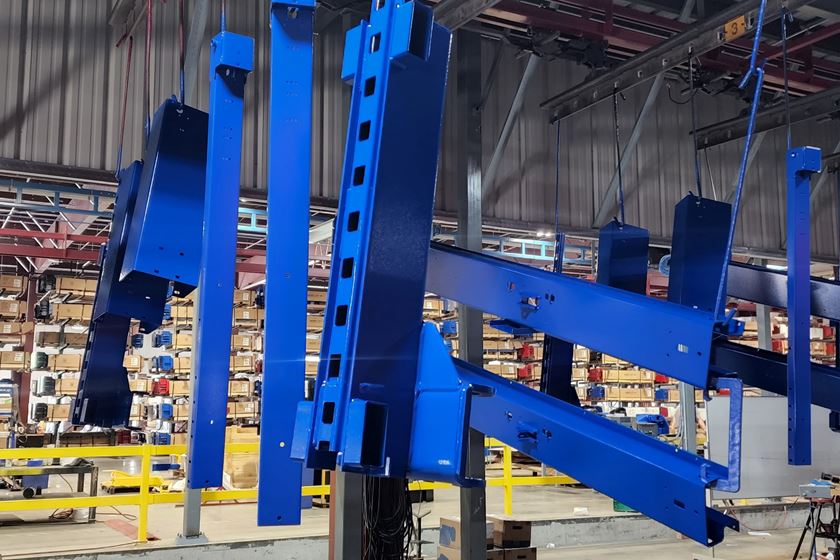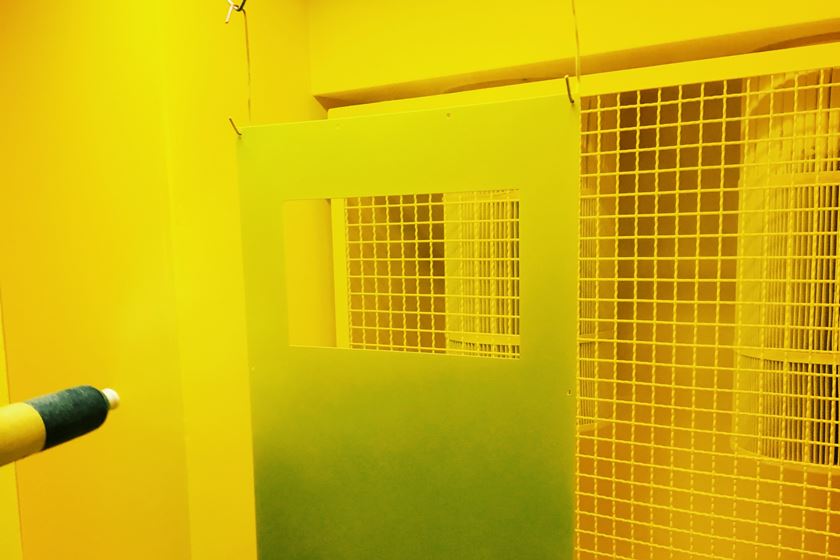New Dip/Spin Facility Improves Efficiency
By moving into a new facility, Depor was able to build a dip/spin line that met its requirements. The new line has improved the company's efficiency and reduced its environmental impact…
#sustainability
Space is often an issue for job shops. Many shops are in buildings more than 30 or 40 years old. As these companies expanded, rooms were added onto the buildings. But with all these smallish rooms and the twists and turns required to get to each one, the finishing processes must be fit to the building instead of the building being fit to the finishing processes. While it may be cheaper to just add a little space here and there to an old building rather than build a new facility, the result can be a dramatic reduction in efficiency.
Depor Industries, Inc. (Troy, MI) was faced with this exact dilemma recently -add onto the existing building and make sacrifices and accommodations in its dip/spin process or build a new facility that would allow the company to install its ideal finishing system. While it was a difficult decision, Depor decided to construct the new facility to overcome a number of challenges the company was facing.
Featured Content
Line Configuration
At Depor's previous facility, its six paint machines were scattered throughout the plant, making the routing of orders a difficult process to navigate. But with the move to a new facility, Depor was able to put its entire finishing system (pretreatment, dip/spin and waste treatment) in one large space.
"What we have is a circular pattern," said Ted Howard, general manager at Depor. "Parts come from shipping to pretreatment to paint to topcoat to final inspection to shipping all in one loop. We don't have the possibility of mixing lots together anymore. It's much easier to manage. You don't have to have three people out on the shop floor just to be in charge of tracking the progress of parts."
Another advantage to the new line configuration is that Depor is able to dedicate four of its paint machines to its primary products; the other two paint machines are used for quick turnaround orders and color changes.
Many of Depor's coatings are supplied by Magni Industries, Inc. Depor relies on Magni to continually evaluate the paints it is using to ensure that any material on environmental hit lists for elimination or reduction is avoided whenever possible. Depor also uses a number of chrome-free coatings that are drop-in replacements for other coatings it has used in the past.
Assigning a material to each dip/spin machine has made the routing of orders easier. "People know exactly what route these parts take each time they come in. Your high-low drivers and machine operators are in a better position to control the flow of product without a supervisor having to step in," said Mr. Howard.
Dedicating various paints to each machine also makes Depor's process more efficient. "Each of our lines is slightly different in the way it presents parts to the dip/spin machine," explained Mr. Howard. "We've got enough capacity that we've got four lines dedicated to our primary products and two lines that we dedicated to paint changes. Those that we change, we've conceded that the efficiency will be less on those two. But, we make up for it because the other four keep rolling. When a customer calls in at three o'clock on Friday afternoon and says 'I need it in two hours,' we've got a line we can cut into and make a paint change, make the customer happy with that one part and not cut into the high volume parts."
Environmental Considerations
The extra space Depor has at its new facility allowed it to make a number of improvements, most notably to the phosphate line, wastewater treatment system and air exhaust for the dip/spin machines, that reduced the company's environmental impact.
Phosphate Line. With a phosphate line, the most important environmental concern is the amount of zinc discharged. There are all kinds of methods, varying in complexity and cost, to reduce the amount of zinc discharged.
"Since we were starting fresh with a brand new line we had an opportunity to spend a little money knowing the payback we would have in the way of clean water. Things like drag out tanks on the phosphate line and counterflowing rinses require very little investment. You can spend just a few dollars for an extra tank and then program a line to make an extra dip before it goes to a sealer for example. It's a huge payback in the way of reducing the amount of zinc that goes to the wastewater," stated Mr. Howard.
Wastewater Treatment System. By nature, job shops process a variety of parts from a variety of manufacturers. That means you're never quite certain what sort of oils and contaminants are coming off the parts during cleaning and are sent through the wastewater treatment system. Not only are you unsure of what's going through your system, you can't even predict what those contaminants are going to be.
In addition to the uncertainty of its waste stream, Depor, like many finishers, had a relatively small waste treatment system. "We learned from experience that volume is the most important consideration. In the past, we had a very low volume," said Mr. Howard. "Therefore, you have a very short time to react to spikes when you get a higher concentration of something. If you've got 100-gallon retention tanks and a system rated at 20 gpm, then you've got five minutes to react. On the other hand if you have 15,000-gallon tanks and a system rated at 20 gpm, you've got a considerably longer time to react."
Since larger wastewater treatment tanks are relatively inexpensive, the investment in larger tanks is small compared to the waste treatment benefits. "We now have a volume that allows us to deal with the spikes and even things out," said Mr. Howard. "It's less maintenance. You don't have to have someone stationed there all day to deal with it. We also have enough volume in those tanks so that in the event we have a problem in one of our phosphate tanks, we can pump the entire contents of the phosphate line out into the holding tanks, do whatever maintenance is necessary and pump it right back in."
Air Exhaust. Just as limited space at its old facility kept Depor from adding extra tanks to its pretreatment system and larger wastewater holding tanks, the poorly configured line made the air exhaust from the paint machines less efficient. Because the paint machines were spread throughout Depor's previous facility, the air ducts contained numerous bends, elbows and drop downs, all of which slowed down the air speed of the exhaust system.
At its new facility, Depor was able to put all six of its paint machines in a straight line, reducing the number of bends and elbows in the air exhaust system. "Here we are able to have them all in one straight shot so that a single header runs from the oxidizer all the way to the other end of the building. From there you connect your drop downs to each oven. What that means is you can have 20,000 cfm and have enough air volume to exhaust seven or eight paint machines very effectively whereas at our old facility we would have been hard pressed to exhaust four or five paint machines with 20,000 cfm because of all the bends," explained Mr. Howard.
Foreign Material
Another significant problem for many dip/spin coaters, as well as barrel platers and heat treaters, is foreign material, or the mixing of parts between orders. Dip/spin coaters have a problem with foreign material because they are running a continuous process where different customers' product is processed one right after the other. Because many of the parts that dip/spin coaters finish are designed to clip onto metal objects or are small enough to get trapped in the system, parts can easily get caught and then dislodged when another batch is processed.
Reducing the amount of foreign material requires a lot of work for the dip/spin coater, and for Depor it even required a little more space. According to Mr. Howard, "To eliminate foreign material you do everything under the sun. We use magnetic conveyors rather than rubber. You need a little more room to accommodate a magnetic conveyor, which we didn't have at the old facility. We had to stick with something inferior because it fit. Magnetic conveyors keep parts from getting caught on the flaps or flights on the old rubber conveyors. We also use low-profile vibratory traps to help operators inspect. You have to engineer out every nook and cranny that you can, go to wide open spaces and avoid bottlenecks."
Working Conditions
The move to a new facility has also improved employee morale and the shop's quality of work. For example, the new air exhaust system has made the working conditions more comfortable for employees. "It leaves a little extra air volume to put hoods over the entry to the ovens and put some exhaust in each of the paint booths. That translates to better working conditions," said Mr. Howard.
"Then you throw in things like better lighting and a more open, brighter lunch room and you get operators who pay a lot more attention to detail and who are a lot more diligent in their inspections."
So, moving to a new facility that was designed for its needs has made a world of difference for Depor. It has given the company the freedom to stop making concessions and sacrifices because of the lack of space and to start finishing parts with its ideal system.
RELATED CONTENT
-
A Current Affair: Examining the "No Amperage" Phenomenon
If you are performing a coating process that requires the use of a rectifier, you may have experienced the "no amperage" problem. Here's a look at the phenomenon and some solutions…
-
Paint Application Methods
An overview of spraying, dipping, flow coating, and everything in between.
-
Pretreatment for Painting
Better adhesion, enhanced corrosion and blister resistance, and reduced coating-part interactions make pretreatment a must.


.JPG;width=70;height=70;mode=crop)
















